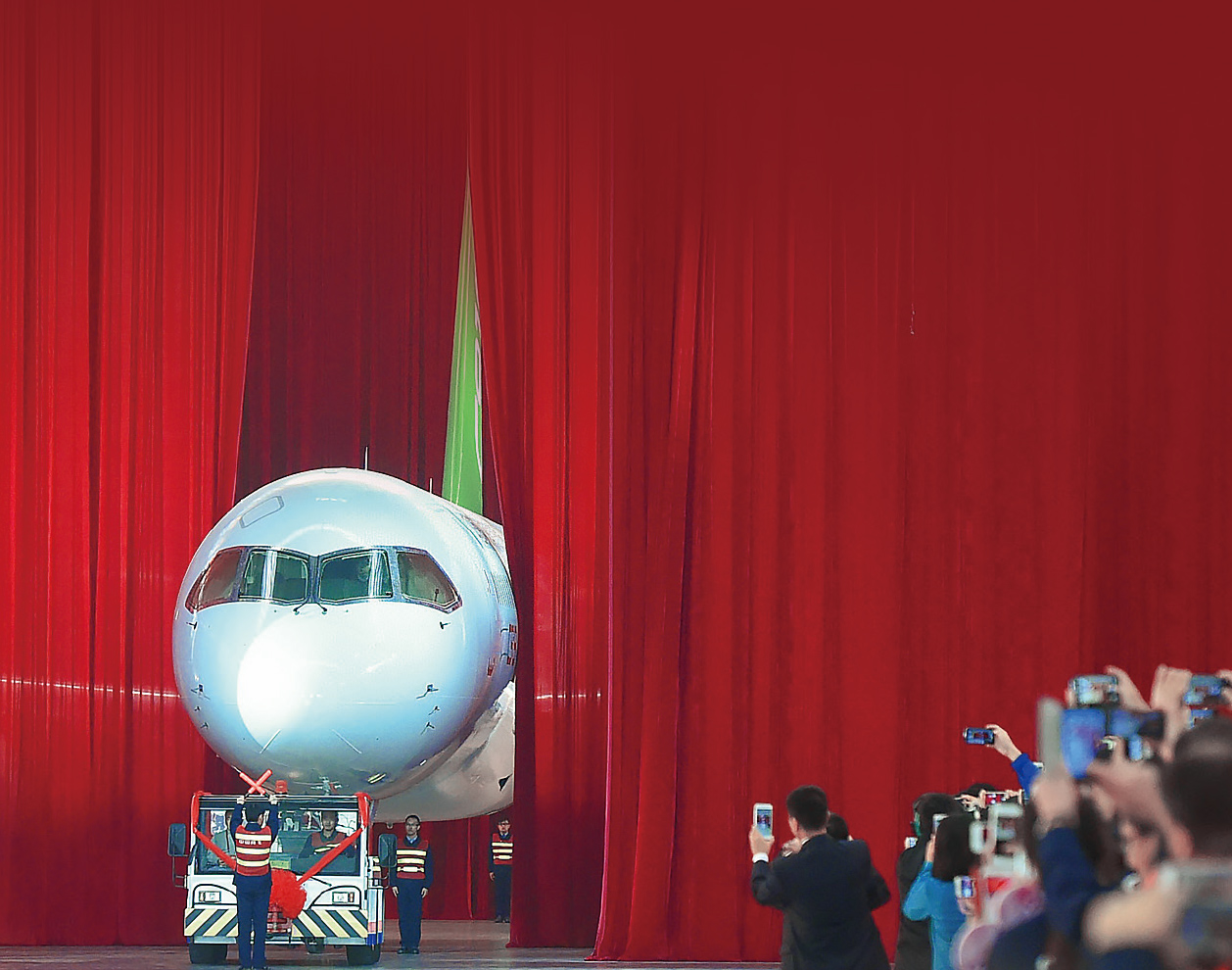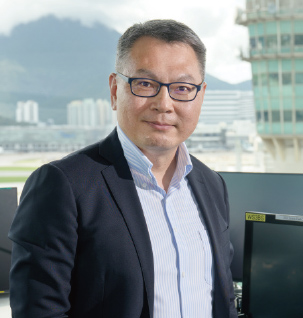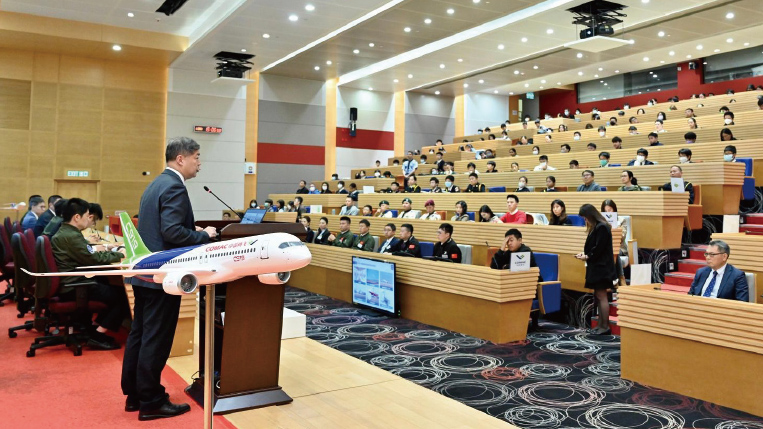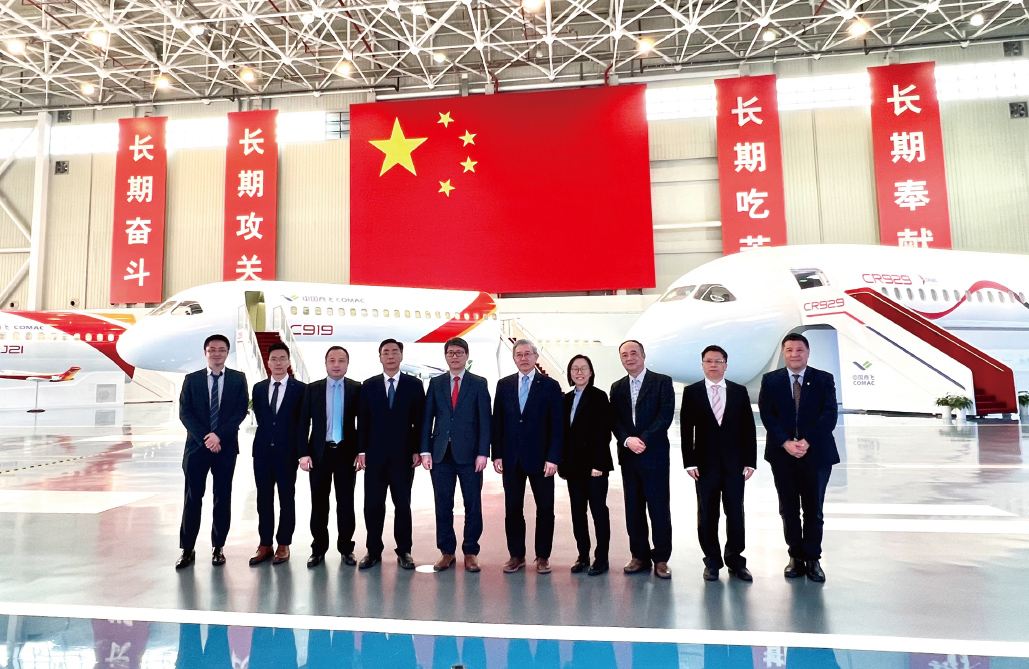

Work Together for Sustainable Development of Country’s Civil Aviation Industry
Home-developed aircraft C919 and ARJ21 landed in Hong Kong for the first time in December last year. The event marked the C919 aircraft’s first voyage out of the Mainland. Victor Liu, Director-General of Civil Aviation, pointed out that the Civil Aviation Department (CAD) has played an active role in the development of the country’s civil aviation industry over the years. It has worked closely with the Civil Aviation Administration of China (CAAC), making significant progress in modernization of management as well as adoption and implementation of international standards in the industry, among many aspects.
Participated in aircraft certification project and overcame pandemic challenges
 “Key projects of cooperation between CAD and CAAC include the C919 aircraft operational evaluation and the joint maintenance management. I am very proud and honoured to have the opportunity to contribute to the prosperous development of the country and Hong Kong.” Liu said that China’s successful development of the C919 aircraft and its choice of Hong Kong as the first place for it to set foot on outside Mainland cities fully reflect the country’s emphasis on the development of Hong Kong’s aviation industry.
“Key projects of cooperation between CAD and CAAC include the C919 aircraft operational evaluation and the joint maintenance management. I am very proud and honoured to have the opportunity to contribute to the prosperous development of the country and Hong Kong.” Liu said that China’s successful development of the C919 aircraft and its choice of Hong Kong as the first place for it to set foot on outside Mainland cities fully reflect the country’s emphasis on the development of Hong Kong’s aviation industry.
CAD has participated in the C919 aircraft certification project at the invitation of CAAC since 2012, mainly providing support in initial certification and continued airworthiness. Liu said that CAD has actively participated in the joint evaluation of the C919 aircraft over the years, including specially deploying airworthiness and flight operations experts to participate in over 80 meetings related to various evaluation boards and expert working groups. “The representatives persisted in holding meetings through online platforms even during the most severe period of the pandemic, demonstrating a commendable spirit.”
In line with international civil aviation standards and reach high-quality technical  level
level
Liu said that his colleagues at CAD, who have extensive professional knowledge and practical experience in the fields of airworthiness certification and flight operations evaluation, took this precious opportunity to put their expertise into use by participating in the C919 project. “The C919 aircraft is strictly designed, manufactured and certificated in accordance with international airworthiness standards and is comparable to current mainstream passenger aircraft in terms of performance and high-end system configuration. Moreover, the type certification standards it uses are even higher than some of the mainstream passenger aircraft. This shows that the country’s aviation manufacturing industry has achieved high-quality development and technical level.”
“At the same time, CAD sent a flight operations expert to Shanghai for two months in 2022 to participate in the C919 T5 test for flight crew training.” Liu explained that the T5 test was the last critical stage in the aircraft evaluation process, covering evaluation, refinement and certification of the training programmes for C919 pilots. After successfully completing the T5 test, the flight operations expert also became one of the first pilots in the world awarded with C919 type rating.”
Showcasing aviation development potential on international stage
CAD has accumulated valuable experience and memories in participating in the country’s key development project. Liu is pleased to see his colleagues contributing their expertise to this end, witnessing the C919 aircraft gaining entry into the civil aviation market, and making relevant preparations for the continuing airworthiness of large aircraft and future operations in Hong Kong. “As far as we know, Commercial Aircraft Corporation of China (COMAC) has received orders for more than 1,000 C919 aircraft. The ARJ21 aircraft was delivered to overseas customer in 2022, marking its entry into the international market.”
The C919 and ARJ21 aircraft have conducted demonstration flights in five Southeast Asian countries early this year, paving the way for market expansion. Looking ahead to the development prospects of the country’s civil aviation industry, Liu believes that Hong Kongers will soon be able to fly on the country’s home-developed aircraft. Hong Kong will also continue playing the role of connecting the world with the country’s backing, letting the world appreciate the strength and development potential of the country’s aviation industry.

PolyU and COMAC are Driving Innovation and Advances in Civil Aviation Technology through Industry-University-Research Collaboration
PolyU and Commercial Aircraft Corporation of China (COMAC) have signed a memorandum of understanding to promote development of civil aviation technology and the industry. According to Zhong Siyang, Assistant Professor of Department of Aeronautical and Aviation Engineering at PolyU, their wide-spectrum cooperation aims for extensive and in-depth joint efforts to drive innovation and progress of civil aviation technology, as well as creating more opportunities for academic and industry exchanges.
Maintaining leadership in quality and developing new technologies
 Zhong also points out, “To date, the PolyU and COMAC teams have launched joint projects in two areas: blockchain-based digital aircraft technology transmission and self-learning based online quality assessment.” As aircraft research and development made inroads, a discussion session was held earlier where the two sides agreed on preliminary docking projects for aircraft noise, navigation technology, new aircraft materials and other issues. He believes their cooperation will gradually lead to industrialization and continue to strengthen in the future.
Zhong also points out, “To date, the PolyU and COMAC teams have launched joint projects in two areas: blockchain-based digital aircraft technology transmission and self-learning based online quality assessment.” As aircraft research and development made inroads, a discussion session was held earlier where the two sides agreed on preliminary docking projects for aircraft noise, navigation technology, new aircraft materials and other issues. He believes their cooperation will gradually lead to industrialization and continue to strengthen in the future.
Commenting on the technological breakthrough in the successful development of China’s homegrown civil passenger aircraft, Zhong stresses that the greatest breakthrough came from the commodity-oriented R&D project. Market competitiveness is very important for a civil airliner which is a commercial product. To achieve this goal, the large passenger aircraft must be designed, manufactured and tested for approval in accordance with international airworthiness standards. This is very helpful for accessing the international market. “Aircraft development is a systematic project supported by an existing industry. As a commodity, a commercial airliner must be superior in performance and quality. It is also important to reduce cost to maintain competitiveness, and to continue with innovation to keep abreast of the times by introducing new technologies.”
Hong Kong experts contributing experience to gain competitive edge
Zhong says that in order to enhance competitive advantages, future homegrown commercial aircraft will also need to achieve higher performance standards at the technical level. He hopes to see Hong Kong actively training talents for different functions in the aviation and aeronautical industry. PolyU, through its Department of Aeronautical and Aviation Engineering, is committed to balancing the needs of innovative research and the aviation and aerospace industry. It has also established the Aviation Services Research Centre (ASRC) with Boeing to conduct applied research to nurture aviation and aerospace engineering professionals.
On the prospect of China’s homegrown civil airliners securing a place in the global market and even the aircraft manufacturing sector, Zhong admits it is not easy to obtain airworthiness certification from Europe and the United States. However, Hong Kong’s aviation industry is thriving and the SAR is an international aviation hub. Notably, Hong Kong’s Civil Aviation Department and Airport Authority are backed by highly experienced expert teams, who are expected to provide some assistance in obtaining international certifications. In addition, COMAC has solid R&D and public relations strengths. He believes ultimately this goal can be achieved.




